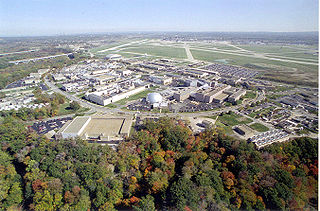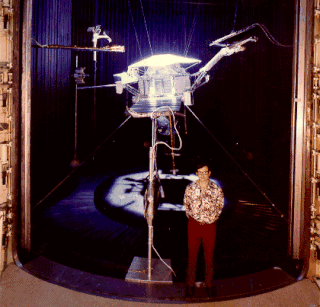
A space suit or spacesuit is a garment worn to keep a human alive in the harsh environment of outer space, vacuum and temperature extremes. Space suits are often worn inside spacecraft as a safety precaution in case of loss of cabin pressure, and are necessary for extravehicular activity (EVA), work done outside spacecraft. Space suits have been worn for such work in Earth orbit, on the surface of the Moon, and en route back to Earth from the Moon. Modern space suits augment the basic pressure garment with a complex system of equipment and environmental systems designed to keep the wearer comfortable, and to minimize the effort required to bend the limbs, resisting a soft pressure garment's natural tendency to stiffen against the vacuum. A self-contained oxygen supply and environmental control system is frequently employed to allow complete freedom of movement, independent of the spacecraft.

The Ames Research Center (ARC), also known as NASA Ames, is a major NASA research center at Moffett Federal Airfield in California's Silicon Valley. It was founded in 1939 as the second National Advisory Committee for Aeronautics (NACA) laboratory. That agency was dissolved and its assets and personnel transferred to the newly created National Aeronautics and Space Administration (NASA) on October 1, 1958. NASA Ames is named in honor of Joseph Sweetman Ames, a physicist and one of the founding members of NACA. At last estimate NASA Ames had over US$3 billion in capital equipment, 2,300 research personnel and a US$860 million annual budget.

An airlock is a room or compartment which permits passage between environments of differing atmospheric pressure or composition, while minimizing the changing of pressure or composition between the differing environments. "Airlock" is sometimes written as air-lock or air lock, or abbreviated to just lock.

NASA John H. Glenn Research Center at Lewis Field is a NASA center within the cities of Brook Park and Cleveland between Cleveland Hopkins International Airport and the Rocky River Reservation of Cleveland Metroparks, with a subsidiary facility in Sandusky, Ohio. Its director is James A. Kenyon. Glenn Research Center is one of ten major NASA facilities, whose primary mission is to develop science and technology for use in aeronautics and space. As of May 2012, it employed about 1,650 civil servants and 1,850 support contractors on or near its site.

A vacuum chamber is a rigid enclosure from which air and other gases are removed by a vacuum pump. This results in a low-pressure environment within the chamber, commonly referred to as a vacuum. A vacuum environment allows researchers to conduct physical experiments or to test mechanical devices which must operate in outer space or for processes such as vacuum drying or vacuum coating. Chambers are typically made of metals which may or may not shield applied external magnetic fields depending on wall thickness, frequency, resistivity, and permeability of the material used. Only some materials are suitable for vacuum use.

The Quest Joint Airlock, previously known as the Joint Airlock Module, is the primary airlock for the International Space Station. Quest was designed to host spacewalks with both Extravehicular Mobility Unit (EMU) spacesuits and Orlan space suits. The airlock was launched on STS-104 on July 14, 2001.

The Neutral Buoyancy Laboratory (NBL) is an astronaut training facility and neutral buoyancy pool operated by NASA and located at the Sonny Carter Training Facility, near the Johnson Space Center in Houston, Texas. The NBL's main feature is a large indoor pool of water, in which astronauts may perform simulated EVA tasks in preparation for upcoming missions. Trainees wear suits designed to provide neutral buoyancy to simulate the microgravity that astronauts experience during spaceflight.

Space Power Facility (SPF) is a NASA facility used to test spaceflight hardware under simulated launch and spaceflight conditions. The SPF is part of NASA's Neil A. Armstrong Test Facility, which in turn is part of the Glenn Research Center. The Neil A. Armstrong Test Facility and the SPF are located near Sandusky, Ohio.

The Neutral Buoyancy Simulator was a neutral buoyancy pool located at NASA's George C. Marshall Space Flight Center (MSFC). Engineers and astronauts developed hardware and practiced procedures in this tank from its completion in 1968 through its decommissioning in 1997. Marshall recognized the need for underwater simulations of extra-vehicular activities (EVAs) and developed three successively larger tanks for the purpose. The Neutral Buoyancy Simulator contributed significantly to the American crewed space program. Skylab, the Space Shuttle, Hubble Space Telescope, and the International Space Station have all benefited from the Neutral Buoyancy Simulator. Until Johnson Space Center constructed the Weightless Environment Test Facility in the mid-1970s, MSFC had the only NASA-owned test facility that allowed engineers and astronauts to become familiar with the dynamics of body motion under weightless conditions.

The Twenty-Five-Foot Space Simulator is a chamber for testing spacecraft in space-like conditions, including extreme cold, high radiation, and near-vacuum pressure. Built in 1961, it is located at the Jet Propulsion Laboratory in Pasadena, California. It has been used to prepare many American space probes for their launches, including the Ranger, Surveyor, Mariner, and Voyager spacecraft.

The Spacecraft Propulsion Research Facility, now known as the In-Space Propulsion Facility, is, the "world’s only facility capable of testing full-scale upper-stage launch vehicles and rocket engines under simulated high-altitude conditions." The facility, located at NASA's Plum Brook Station of the Glenn Research Center near Sandusky, Ohio, was built in 1968. Its first major use was for testing stages of the Centaur Rocket, which was used to launch some of America's most important space probes. The facility was designated a National Historic Landmark in 1985.

The Spacecraft Magnetic Test Facility, also known historically as the Attitude Control Test Facility, is an experimental spacecraft test facility at the Goddard Space Flight Center in Greenbelt, Maryland, United States. It was built in 1966 to allow the evaluation of magnetic movement in crewed and uncrewed spacecraft, and for the precision calibration of magnetometers used in space flight. The building is constructed of non-magnetic materials and contains a magnetic coil system that allows the cancellation of the Earth's magnetic field. This unique building was designated a National Historic Landmark in 1985.

The Zero Gravity Research Facility at the NASA Glenn Research Center, in Cleveland, Ohio, is a unique facility designed to perform tests in a reduced gravity environment. It has successfully supported research for United States crewed spacecraft programs and numerous uncrewed projects. The facility uses vertical drop tests in a vacuum chamber to investigate the behavior of systems, components, liquids, gases, and combustion in microgravity.

A suitport or suitlock is an alternative technology to an airlock, designed for use in hazardous environments including in human spaceflight, especially planetary surface exploration. Suitports present advantages over traditional airlocks in terms of mass, volume, and ability to mitigate contamination by—and of—the local environment.

A thermal vacuum chamber (TVAC) is a vacuum chamber in which the radiative thermal environment is controlled.

An environmental chamber, also called a climatic chamber or climate chamber, is an enclosure used to test the effects of specified environmental conditions on biological items, industrial products, materials, and electronic devices and components.

The Microgravity Science Glovebox (MSG) is a glovebox aboard the International Space Station (ISS). It provides a safe contained environment for research with liquids, combustion and hazardous materials in the microgravity conditions of the ISS. Without the MSG, many types of hands-on investigations would be impossible or severely limited on board the Station. The Microgravity Science Glovebox (MSG) occupies a floor-to-ceiling rack inside the Destiny module of the ISS. It is more than twice as large as gloveboxes flown on the Space Shuttle and could contain larger investigations that are about twice the size of an airline carry-on bag. A follow-on sister facility, managed by the same group at Marshall Space Flight Center, is intended to further support biological experiments with the Life Sciences Glovebox.
The AEDC Space Chambers Test Facility, located at Arnold Engineering Development Complex, contains several test units used for simulating space conditions. The facility has a variety of test cells to accommodate various sized test articles. Test articles range in size from the sensor level all the way up to full-scale space systems. All test units in the facility are owned by the United States Air Force and currently operated by Aerospace Testing Alliance.

A neutral buoyancy pool or neutral buoyancy tank is a pool of water in which neutral buoyancy is used to train astronauts for extravehicular activity and the development of procedures. These pools began to be used in the 1960s and were initially just recreational swimming pools; dedicated facilities would later be built.

The project to create the International Space Station required the utilization and/or construction of new and existing manufacturing facilities around the world, mostly in the United States and Europe. The agencies overseeing the manufacturing involved NASA, Roscosmos, the European Space Agency, JAXA, and the Canadian Space Agency. Hundreds of contractors working for the five space agencies were assigned the task of fabricating the modules, trusses, experiments and other hardware elements for the station.


























